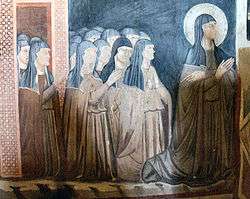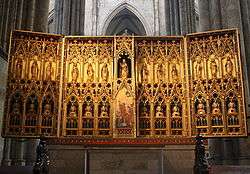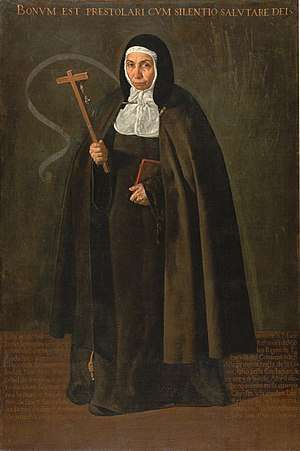Poor Clares
The Poor Clares, officially the Order of Saint Clare (Latin: Ordo sanctae Clarae) – originally referred to as the Order of Poor Ladies, and later the Clarisses, the Minoresses, the Franciscan Clarist Order, and the Second Order of Saint Francis – are members of a contemplative Order of nuns in the Catholic Church. The Poor Clares were the second Franciscan branch of the order to be established. Founded by Saints Clare of Assisi and Francis of Assisi on Palm Sunday in the year 1212, they were organized after the Order of Friars Minor (the first Order), and before the Third Order of Saint Francis for the laity. As of 2011 there were over 20,000 Poor Clare nuns in over 75 countries throughout the world. They follow several different observances and are organized into federations.[1]

The Poor Clares follow the Rule of St. Clare, which was approved by Pope Innocent IV the day before Clare's death in 1253. The main branch of the Order (O.S.C.) follows the observance of Pope Urban. Other branches established since that time, who operate under their own unique Constitutions, are the Colettine Poor Clares (P.C.C.) (founded 1410), the Capuchin Poor Clares (O.S.C. Cap) (founded 1538) and the Poor Clares of Perpetual Adoration (P.C.P.A.) (founded 1854).
Foundation and rule
_(cropped).png)
The Poor Clares were founded by Clare of Assisi in the year 1212. Little is known of Clare's early life, although popular tradition hints that she came from a fairly well-to-do family in Assisi. At the age of eighteen, inspired by the preaching of Francis in the cathedral, Clare ran away from home to join his community of friars at the Portiuncula, some way outside the town.[2] Although, according to tradition, her family wanted to take her back by force, Clare's dedication to holiness and poverty inspired the friars to accept her resolution. She was given the habit of a nun and transferred to Benedictine monasteries, first at Bastia and then at Sant' Angelo di Panzo, for her monastic formation.
By 1216 Francis was able to offer Clare and her companions a monastery adjoining the chapel of San Damiano where she became abbess. Clare's mother, two of her sisters and some other wealthy women from Florence soon joined her new Order. Clare dedicated her order to the strict principles of Francis, setting a rule of extreme poverty far more severe than that of any female order of the time.[3] Clare's determination that her order not be wealthy or own property, and that the nuns live entirely from alms given by local people, was initially protected by the papal bull Privilegium paupertatis, issued by Pope Innocent III.[4] By this time the order had grown to number three monasteries.
Spread of the order
The movement quickly spread, though in a somewhat disorganized fashion, with several monasteries of women devoted to the Franciscan ideal springing up elsewhere in Northern Italy. At this point Ugolino, Cardinal Bishop of Ostia (the future Pope Gregory IX), was given the task of overseeing all such monasteries and preparing a formal rule. Although monasteries at Monticello, Perugia, Siena, Gattajola and elsewhere adopted the new Rule – which allowed for property to be held in trust by the papacy for the various communities – it was not adopted by Clare herself or her monastery at San Damiano.[4] Ugolino's Rule, originally based on the Benedictine one, was amended in 1263 by Pope Urban IV to allow for the communal ownership of property, and was adopted by a growing number of monasteries across Europe. Communities adopting this less rigorous rule came to be known as the Order of Saint Clare (O.S.C.) or the Urbanist Poor Clares.[5]
Clare herself resisted the Ugolino Rule, since it did not closely enough follow the ideal of complete poverty advocated by Francis. On 9 August 1253, she managed to obtain a papal bull, Solet annuere, establishing a rule of her own, more closely following that of the friars, which forbade the possession of property either individually or as a community. Originally applying only to Clare's community at San Damiano, this rule was also adopted by many monasteries.[4] Communities that followed this stricter rule were fewer in number than the followers of the rule formulated by Cardinal Ugolino, and became known simply as "Poor Clares" (P.C.) or Primitives.
The situation was further complicated a century later when Saint Colette of Corbie restored the primitive rule of strict poverty to 17 French monasteries. Her followers came to be called the Colettine Poor Clares (P.C.C.). Two further branches, the Capuchin Poor Clares (O.S.C. Cap.) and the Alcantarines, also followed the strict observance.[5] The later group disappeared as a distinct group when their observance among the friars was ended, with the friars being merged by the Holy See into the wider observant branch of the First Order.
The spread of the order began in 1218 when a monastery was founded in Perugia; new foundations quickly followed in Florence, Venice, Mantua, and Padua. Saint Agnes of Assisi, a sister of Clare, introduced the order to Spain, where Barcelona and Burgos hosted major communities. The order further expanded to Belgium and France where a monastery was founded at Reims in 1229, followed by Montpellier, Cahors, Bordeaux, Metz, and Besançon. A monastery at Marseilles was founded directly from Assisi in 1254.[4] The Poor Clares monastery founded by Queen Margaret in Paris, St. Marcel, was where she died in 1295.[6] King Philip IV and Queen Joan founded a monastery at Moncel in the Beauvais diocese.[6] By A.D. 1300 there were 47 Poor Clare monasteries in Spain alone.[3]
Europe
United Kingdom
The first Poor Clare monastery in England was founded in 1286 in Newcastle upon Tyne.[7] In medieval England, where the nuns were known as "minoresses", their principal monastery was located near Aldgate, known as the Abbey of the Order of St Clare. The order gave its name to the still-extant street known as Minories on the eastern boundary of the City of London.
After the dissolution of the monasteries under King Henry VIII, several religious communities formed in continental Europe for English Catholics. One such was a Poor Clare monastery founded in 1609 at Gravelines by Mary Ward.[7] Later expelled from their monastery by the French Revolutionary Army in 1795, the community eventually relocated to England. They settled first in Northumberland, and then in 1857 built a monastery in Darlington,[7] which was in existence until 2007.
Following Catholic emancipation in the first half of the 19th century, other Poor Clares came to the United Kingdom,[8] eventually establishing communities in, e.g., Notting Hill (1857, which was forced to relocate by the local council in the 1960s, and settled in the village of Arkley in 1969),[9] Woodchester (1860), Much Birch (1880), Arundel (1886), Lynton (founded from Rennes, France, 1904), Woodford Green (1920–1969), York (1865–2015)[10] and Nottingham (1927).
The community in Luton was founded in 1976 to meet a shortage of teachers for local Catholic schools. It was originally based at 18 London Road in a large Edwardian house. In 1996, the community refocused on a ministry of social work and prayer, and moved to a smaller, modern home at Abigail Close, Wardown Park.[11]
Communities of Colettine Poor Clares were founded in England at Baddesley Clinton (1850–2011),[12] Ellesmere, Shropshire and Woodchester. They have communities in Belfast, Northern Ireland, and in Bothwell, Scotland (1952). In Wales, there is a monastery in Hawarden. The one that used to be based in Neath has moved to Glasgow.
Ireland
In Ireland there are seven monasteries of the Colettine Observance. The community with the oldest historical roots is the monastery on Nuns' Island in Galway, which traces its history back to the monastery in Gravelines. Originally a separate community of Irish women under a common mother superior with the English nuns, they moved to Dublin in 1629, the first monastic community in Ireland for a century. The first Abbess was Cecily Dillon, a daughter of Theobald Dillon, 1st Viscount Dillon. War forced the community to move back to Galway in 1642. From that point on, persecution under the Penal Laws and war led to repeated destruction of their monastery and scattering of the community over two centuries, until 1825, when fifteen nuns were able to re-establish monastic life permanently on the site.[13]
Later monasteries were founded in 1906 in both Carlow and Dublin. From these, foundations were established in Cork (1914) and Ennis (1958). In 1973, an enclosed community of nuns of the Franciscan Third Order Regular in Drumshanbo, founded in England in 1852 and established there in 1864, transferred to the Second Order, under this Observance.[14]
Continental Europe

Currently there are communities of Colettine Poor Clares in Bruges, Belgium, as well as in Eindhoven, the Netherlands, and in Larvik, Norway. There are several monasteries in Hungary, Lithuania and Poland of the Urbanist and Capuchin Observances.
There are notable Clarissine churches in Bamberg, Bratislava, Brixen, and Nuremberg. There also is a small community in Münster, Germany and a Capuchin monastery in Sigolsheim, France.
Scandinavia
Americas
United States
After an abortive attempt to establish the Order in the United States in the early 1800s by three nuns who were refugees of Revolutionary France, the Poor Clares were not permanently established in the country until the late 1870s.
A small group of Colettine nuns arrived from Düsseldorf, Germany, seeking a refuge for the community which had been expelled from their monastery by the government policies of the Kulturkampf. They found a welcome in the Diocese of Cleveland, and in 1877 established a monastery in that city. At the urging of Mother Ignatius Hayes, O.S.F., in 1875 Pope Pius IX had already authorized the sending of nuns to establish a monastery of Poor Clares of the Primitive Observance from San Damiano in Assisi. After the reluctance on the part of many bishops to accept them, due to their reliance upon donations for their maintenance, a community was finally established in Omaha, Nebraska, in 1878.[15]
Currently there are also monasteries in (among other places): Alexandria, Virginia (P.C.C);[16] Andover, Massachusetts;[17] Belleville, Illinois (P.C.C.);[18] Bordentown, New Jersey; Boston, Massachusetts; Brenham, Texas; Chicago, Illinois;[19] Cincinnati, Ohio;[20] Cleveland, Ohio (O.S.C., P.C.C. and P.C.P.A.); Evansville, Indiana;[21] Los Altos Hills, California; Memphis, Tennessee;[22] metropolitan Richmond, Virginia;[23] New Orleans; Philadelphia, Pennsylvania;[24]Phoenix, Arizona; Rockford, Illinois (P.C.C.);[25] Roswell, New Mexico (P.C.C.);[26] Saginaw, Michigan; Spokane, Washington;[27]/ Travelers Rest, South Carolina; Washington D.C.;[28] and Wappingers Falls, New York.[29] Additionally there are monasteries in Alabama (P.C.P.A.), California, Florida, Missouri, Montana and Tennessee. Since the 1980s, the nuns of New York City have formed small satellite communities in Connecticut and New Jersey. There is one monastery of the Capuchin Observance in Denver, Colorado, founded from Mexico in 1988.[30]
Canada
There are three monasteries of the Order in Canada: St. Clare's Monastery at Duncan, British Columbia; and at Mission, British Columbia; and a French-speaking community in Valleyfield, Quebec.[30]

Latin America
There have been monasteries of the Order in Mexico since colonial days. The Capuchin nuns alone number some 1,350 living in 73 different monasteries around the country.[31]
A monastery was founded in Huehuetenango, Guatemala, by nuns from the community in Memphis, Tennessee, in November 1981, in the early days of a bloody civil war which ravaged that country; as of 2011, it consisted of seven nuns; five Guatemalans and two Salvadorans.[32]
Asia
The Poor Clares were introduced to the Philippines in the 17th century, when a small community of Colettine nuns were authorized by the King of Spain and the Minister General of the Order to go there to found a monastery. They were led by Mother Jeronima of the Assumption, P.C.C., who was appointed Abbess. Leaving Madrid in April 1620, they arrived in Manila on 5 August 1621. The monastery still stands and serves an active community of nuns.
Communities are now also established in Aritao, the Philippines, and Kiryū, Gunma, Japan, which was founded from the monastery in Boston in 1965.[33]
Connections with television
- In 1958 Saint Clare was declared the patron saint of television by the Catholic Church.
- The Eternal Word Television Network (EWTN) is operated by the Poor Clares of Perpetual Adoration in Alabama.
- In June and July 2006 BBC Two broadcast a television series called The Convent,[34] in which four women were admitted to a Poor Clare monastery in southern England, for a period of six weeks, to observe the life.
References
- "Poor Clare Sisters". Retrieved 9 December 2016.
- Michael Walsh (ed.). Butler's lives of the Saints, Burns and Oates (1991) p. 246.
- Farmer, David (ed.) Oxford Dictionary of Saints, Oxford University Press (1997), p. 103
- "Poor Clares". The Catholic Encyclopedia, New Advent. Retrieved 10 November 2009.
- Encyclopædia Britannica, 2007, Vol.9. p. 603
- Queen Isabella (c.1295/1358) and the Greyfriars: An example of royal patronage based on her accounts for 1357/1358, Michael Robson, Franciscan Studies, Vol. 65 (2007), 328.
- "History of the Poor Clare Order in Britain - The Poor Clare Monastery, Hereford". Retrieved 9 December 2016.
- McKeown, Paul. "Franciscans and Poor Clares(UK) - Links to Franciscans and Poor Clares". Retrieved 9 December 2016.
- Arkley Poor Clare Monastery Archived 23 January 2011 at the Wayback Machine
- "Convent life on the quiet". York Press. Retrieved 21 April 2020.
- "Luton". Sisters of St Clare.
- This community, reduced to four nuns, closed January 2011 and the nuns dispersed to other communities of the order, Archived 23 February 2018 at the Wayback Machine
- Team, Marek Mazur &. "Poor Clares Galway - Ireland". Archived from the original on 2 November 2016. Retrieved 9 December 2016.
- "Poor Clares of Drumshanbo "History"". Archived from the original on 4 March 2016. Retrieved 2 December 2011.
- "Home - Poor Clare Sisters of Omaha". Retrieved 9 December 2016.
- "Poor Clare Monastery of Mary, Mother of the Church". Archived from the original on 3 December 2013. Retrieved 9 December 2016.
- "Home". 3 December 2009. Archived from the original on 3 December 2009. Retrieved 21 April 2020.
- "Poor Clare Nuns Belleville - Who We Are Today". Retrieved 9 December 2016.
- "Poor Clares of Chicago -- Home Page". Retrieved 9 December 2016.
- "Poor Clares Cincinnati". Retrieved 9 December 2016.
- "Poor Clare Sisters of Evansville, Indiana, the Second Order of St. Francis". Retrieved 9 December 2016.
- "Capuchins,, Memphis". poorclare.org. Retrieved 21 April 2020.
- "Bethlehem Monastery - Barhamsville, Virginia". Retrieved 9 December 2016.
- "Poor Clare PA – Langhorne, PA". Retrieved 9 December 2016.
- Clare Colettine Nuns, Rockford, Illinois
- "Poor Clares of Roswell". Retrieved 9 December 2016.
- "Called by Joy - The Poor Clare Sisters of Spokane, Washington". Retrieved 9 December 2016.
- "Welcome". Retrieved 9 December 2016.
- "Archived copy". Archived from the original on 8 December 2013. Retrieved 11 August 2013.CS1 maint: archived copy as title (link)
- Clare of Assisi: On the Wealth of Poverty, by Martina Kreidler-Kos and Sr. Ancilla Röttger, OSC ISBN 978-2-7468-2569-7 Published by Editions du Signe, France
- "Capuchin". www.capuchins.org. Retrieved 21 April 2020.
- Hermanas Clarisas "Sobre Nosotras" (in Spanish)
- "Poor Clares, Japan". poorclare.org. Retrieved 21 April 2020.
- Poor Clares, Arundel Archived 19 November 2009 at the Wayback Machine
External links
| Wikimedia Commons has media related to Poor Clares. |
- Poor Clares Official U.S. website
- The Catholic Encyclopedia: The Poor Clares
- Prayer for Poor Clare and Franciscan Vocations
- The Convent television series
- . Encyclopædia Britannica (11th ed.). 1911.

